oil Hyundai Elantra 2015 - RHD (UK. Australia) Owner's Guide
[x] Cancel search | Manufacturer: HYUNDAI, Model Year: 2015, Model line: Elantra, Model: Hyundai Elantra 2015Pages: 498, PDF Size: 9.45 MB
Page 448 of 498
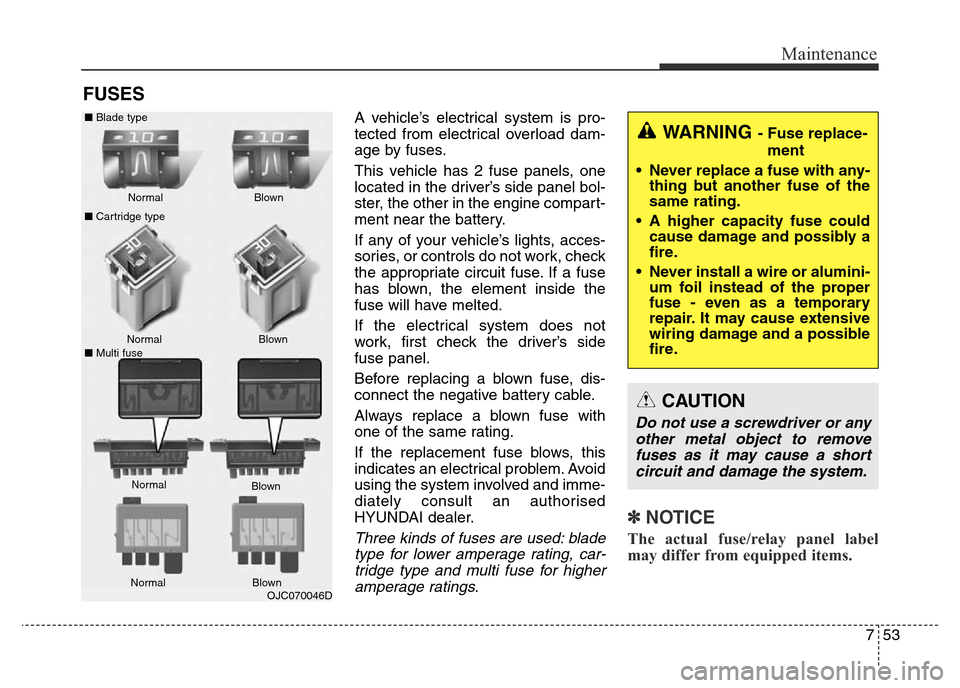
753
Maintenance
FUSES
A vehicle’s electrical system is pro-
tected from electrical overload dam-
age by fuses.
This vehicle has 2 fuse panels, one
located in the driver’s side panel bol-
ster, the other in the engine compart-
ment near the battery.
If any of your vehicle’s lights, acces-
sories, or controls do not work, check
the appropriate circuit fuse. If a fuse
has blown, the element inside the
fuse will have melted.
If the electrical system does not
work, first check the driver’s side
fuse panel.
Before replacing a blown fuse, dis-
connect the negative battery cable.
Always replace a blown fuse with
one of the same rating.
If the replacement fuse blows, this
indicates an electrical problem. Avoid
using the system involved and imme-
diately consult an authorised
HYUNDAI dealer.
Three kinds of fuses are used: blade
type for lower amperage rating, car-
tridge type and multi fuse for higher
amperage ratings.
✽NOTICE
The actual fuse/relay panel label
may differ from equipped items.
WARNING - Fuse replace-
ment
• Never replace a fuse with any-
thing but another fuse of the
same rating.
• A higher capacity fuse could
cause damage and possibly a
fire.
• Never install a wire or alumini-
um foil instead of the proper
fuse - even as a temporary
repair. It may cause extensive
wiring damage and a possible
fire.
CAUTION
Do not use a screwdriver or any
other metal object to remove
fuses as it may cause a short
circuit and damage the system.
OJC070046D NormalNormal
■Cartridge type
■Multi fuseBlown
Blown
Normal
Blown ■Blade type
NormalBlown
Page 458 of 498
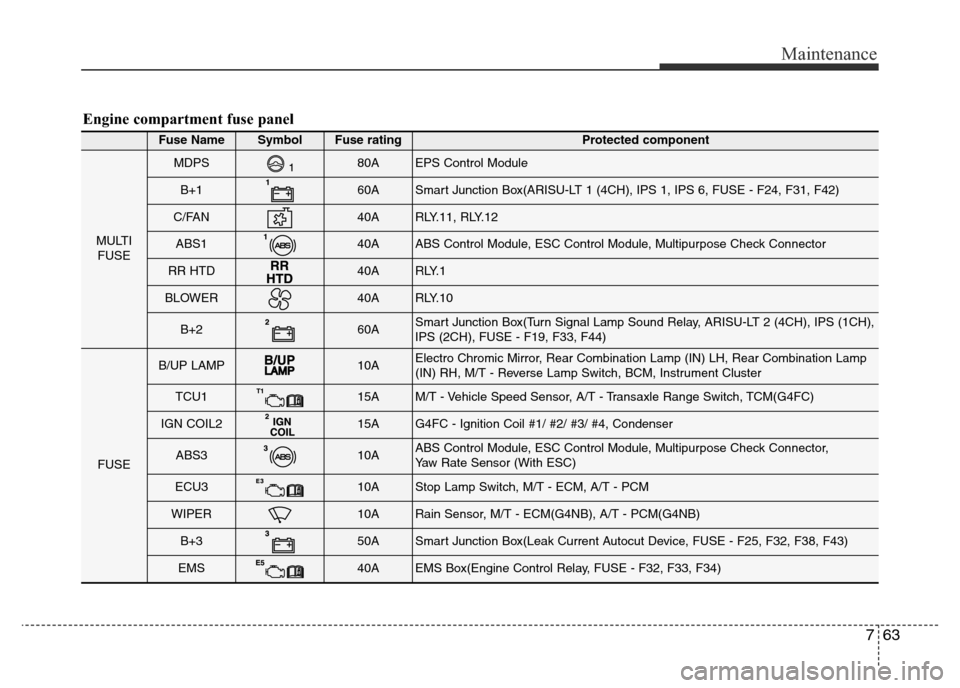
763
Maintenance
Engine compartment fuse panel
Fuse NameSymbol Fuse ratingProtected component
MULTI
FUSE
MDPS80AEPS Control Module
B+160ASmart Junction Box(ARISU-LT 1 (4CH), IPS 1, IPS 6, FUSE - F24, F31, F42)
C/FAN40ARLY.11, RLY.12
ABS140AABS Control Module, ESC Control Module, Multipurpose Check Connector
RR HTD40AR LY. 1
BLOWER40ARLY.10
B+260ASmart Junction Box(Turn Signal Lamp Sound Relay, ARISU-LT 2 (4CH), IPS (1CH),
IPS (2CH), FUSE - F19, F33, F44)
FUSE
B/UP LAMP10AElectro Chromic Mirror, Rear Combination Lamp (IN) LH, Rear Combination Lamp
(IN) RH, M/T - Reverse Lamp Switch, BCM, Instrument Cluster
TCU115AM/T - Vehicle Speed Sensor, A/T - Transaxle Range Switch, TCM(G4FC)
IGN COIL215AG4FC - Ignition Coil #1/ #2/ #3/ #4, Condenser
ABS310AABS Control Module, ESC Control Module, Multipurpose Check Connector,
Yaw Rate Sensor (With ESC)
ECU310AStop Lamp Switch, M/T - ECM, A/T - PCM
WIPER10ARain Sensor, M/T - ECM(G4NB), A/T - PCM(G4NB)
B+350ASmart Junction Box(Leak Current Autocut Device, FUSE - F25, F32, F38, F43)
EMS40AEMS Box(Engine Control Relay, FUSE - F32, F33, F34)
Page 460 of 498
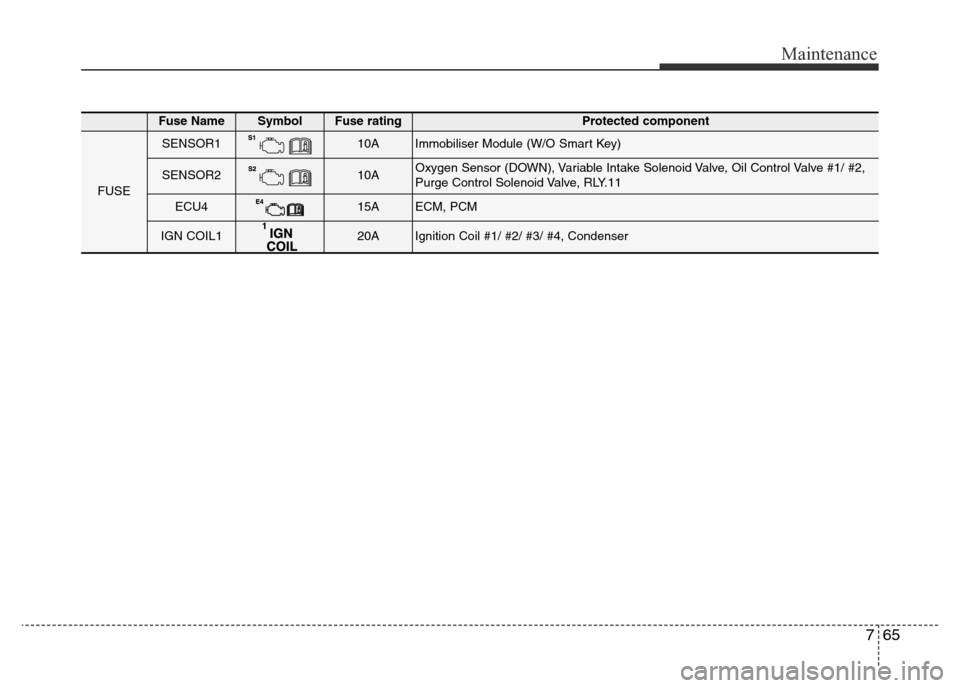
765
Maintenance
Fuse NameSymbol Fuse ratingProtected component
FUSE
SENSOR110AImmobiliser Module (W/O Smart Key)
SENSOR210AOxygen Sensor (DOWN), Variable Intake Solenoid Valve, Oil Control Valve #1/ #2,
Purge Control Solenoid Valve, RLY.11
ECU415AECM, PCM
IGN COIL120AIgnition Coil #1/ #2/ #3/ #4, Condenser
Page 463 of 498
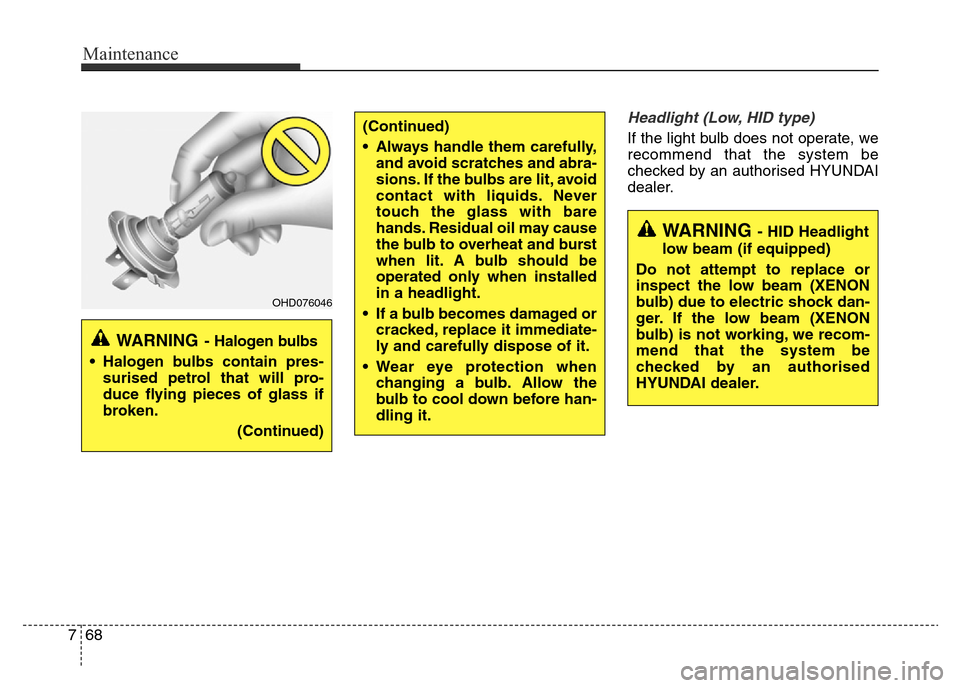
Maintenance
68 7
Headlight (Low, HID type)
If the light bulb does not operate, we
recommend that the system be
checked by an authorised HYUNDAI
dealer.(Continued)
• Always handle them carefully,
and avoid scratches and abra-
sions. If the bulbs are lit, avoid
contact with liquids. Never
touch the glass with bare
hands. Residual oil may cause
the bulb to overheat and burst
when lit. A bulb should be
operated only when installed
in a headlight.
• If a bulb becomes damaged or
cracked, replace it immediate-
ly and carefully dispose of it.
• Wear eye protection when
changing a bulb. Allow the
bulb to cool down before han-
dling it.
WARNING- Halogen bulbs
• Halogen bulbs contain pres-
surised petrol that will pro-
duce flying pieces of glass if
broken.
(Continued)
OHD076046
WARNING - HID Headlight
low beam (if equipped)
Do not attempt to replace or
inspect the low beam (XENON
bulb) due to electric shock dan-
ger. If the low beam (XENON
bulb) is not working, we recom-
mend that the system be
checked by an authorised
HYUNDAI dealer.
Page 480 of 498
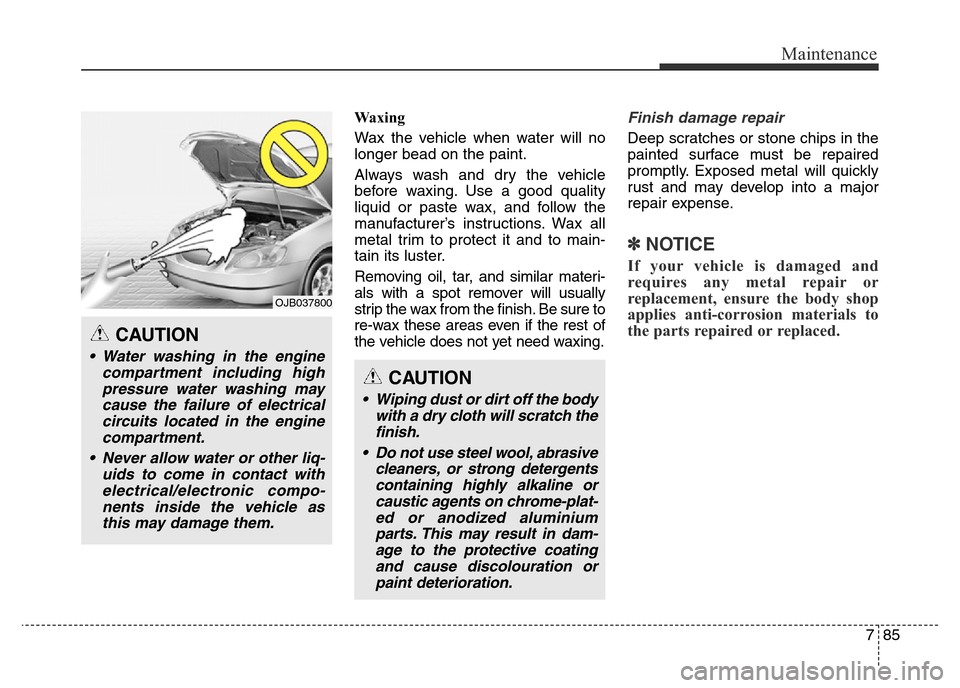
785
Maintenance
Waxing
Wax the vehicle when water will no
longer bead on the paint.
Always wash and dry the vehicle
before waxing. Use a good quality
liquid or paste wax, and follow the
manufacturer’s instructions. Wax all
metal trim to protect it and to main-
tain its luster.
Removing oil, tar, and similar materi-
als with a spot remover will usually
strip the wax from the finish. Be sure to
re-wax these areas even if the rest of
the vehicle does not yet need waxing.Finish damage repair
Deep scratches or stone chips in the
painted surface must be repaired
promptly. Exposed metal will quickly
rust and may develop into a major
repair expense.
✽NOTICE
If your vehicle is damaged and
requires any metal repair or
replacement, ensure the body shop
applies anti-corrosion materials to
the parts repaired or replaced.
CAUTION
• Wiping dust or dirt off the body
with a dry cloth will scratch the
finish.
• Do not use steel wool, abrasive
cleaners, or strong detergents
containing highly alkaline or
caustic agents on chrome-plat-
ed or anodized aluminium
parts. This may result in dam-
age to the protective coating
and cause discolouration or
paint deterioration.
CAUTION
• Water washing in the engine
compartment including high
pressure water washing may
cause the failure of electrical
circuits located in the engine
compartment.
• Never allow water or other liq-
uids to come in contact with
electrical/electronic compo-
nents inside the vehicle as
this may damage them.
OJB037800
Page 484 of 498
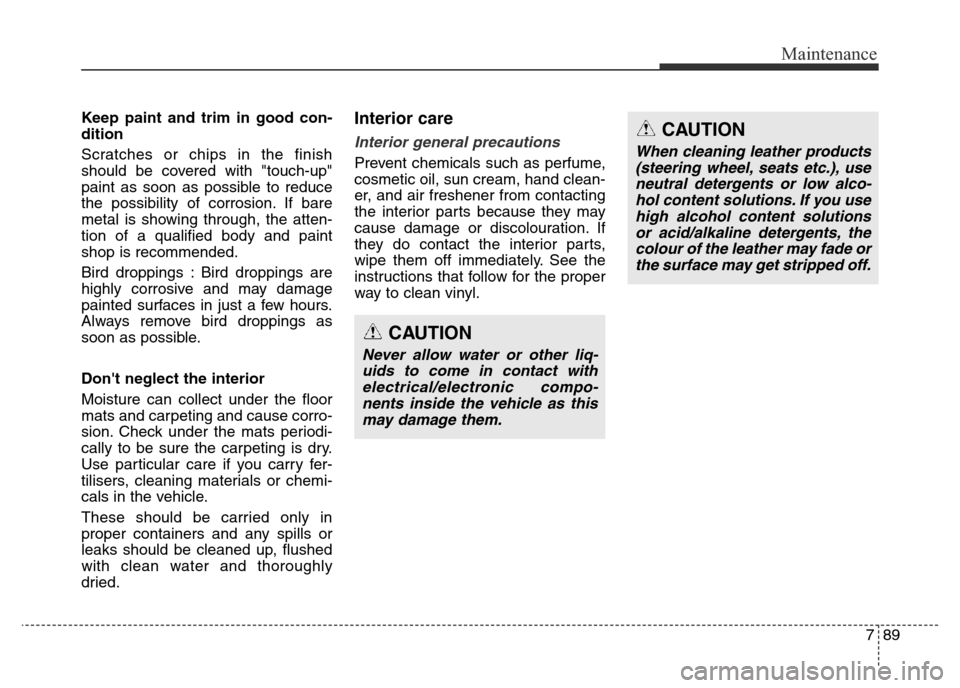
789
Maintenance
Keep paint and trim in good con-
dition
Scratches or chips in the finish
should be covered with "touch-up"
paint as soon as possible to reduce
the possibility of corrosion. If bare
metal is showing through, the atten-
tion of a qualified body and paint
shop is recommended.
Bird droppings : Bird droppings are
highly corrosive and may damage
painted surfaces in just a few hours.
Always remove bird droppings as
soon as possible.
Don't neglect the interior
Moisture can collect under the floor
mats and carpeting and cause corro-
sion. Check under the mats periodi-
cally to be sure the carpeting is dry.
Use particular care if you carry fer-
tilisers, cleaning materials or chemi-
cals in the vehicle.
These should be carried only in
proper containers and any spills or
leaks should be cleaned up, flushed
with clean water and thoroughly
dried.Interior care
Interior general precautions
Prevent chemicals such as perfume,
cosmetic oil, sun cream, hand clean-
er, and air freshener from contacting
the interior parts because they may
cause damage or discolouration. If
they do contact the interior parts,
wipe them off immediately. See the
instructions that follow for the proper
way to clean vinyl.
CAUTION
Never allow water or other liq-
uids to come in contact with
electrical/electronic compo-
nents inside the vehicle as this
may damage them.
CAUTION
When cleaning leather products
(steering wheel, seats etc.), use
neutral detergents or low alco-
hol content solutions. If you use
high alcohol content solutions
or acid/alkaline detergents, the
colour of the leather may fade or
the surface may get stripped off.
Page 485 of 498
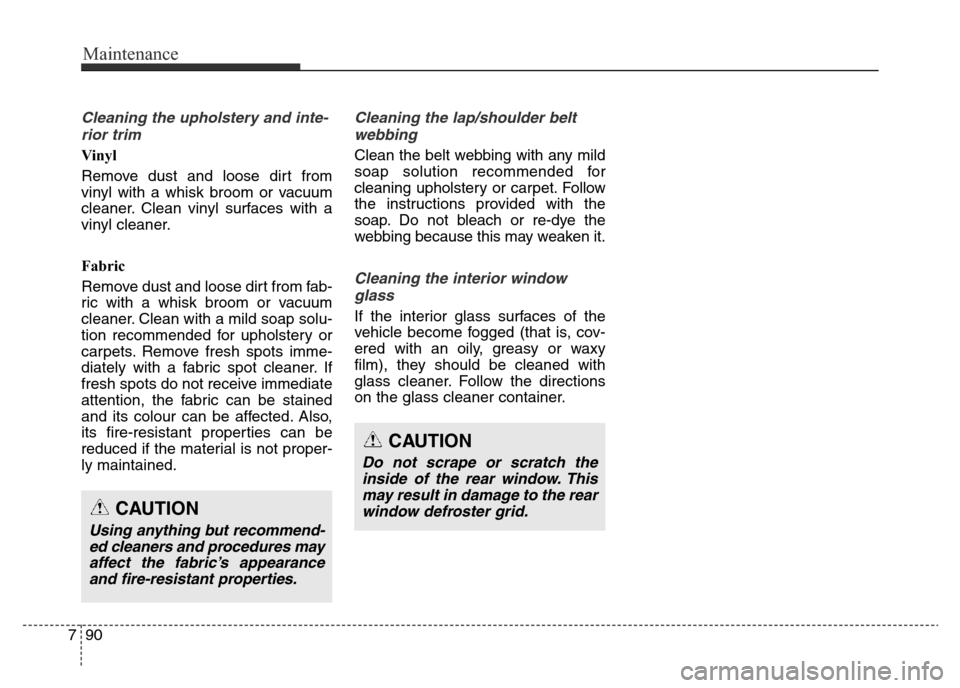
Maintenance
90 7
Cleaning the upholstery and inte-
rior trim
Vinyl
Remove dust and loose dirt from
vinyl with a whisk broom or vacuum
cleaner. Clean vinyl surfaces with a
vinyl cleaner.
Fabric
Remove dust and loose dirt from fab-
ric with a whisk broom or vacuum
cleaner. Clean with a mild soap solu-
tion recommended for upholstery or
carpets. Remove fresh spots imme-
diately with a fabric spot cleaner. If
fresh spots do not receive immediate
attention, the fabric can be stained
and its colour can be affected. Also,
its fire-resistant properties can be
reduced if the material is not proper-
ly maintained.
Cleaning the lap/shoulder belt
webbing
Clean the belt webbing with any mild
soap solution recommended for
cleaning upholstery or carpet. Follow
the instructions provided with the
soap. Do not bleach or re-dye the
webbing because this may weaken it.
Cleaning the interior window
glass
If the interior glass surfaces of the
vehicle become fogged (that is, cov-
ered with an oily, greasy or waxy
film), they should be cleaned with
glass cleaner. Follow the directions
on the glass cleaner container.
CAUTION
Using anything but recommend-
ed cleaners and procedures may
affect the fabric’s appearance
and fire-resistant properties.
CAUTION
Do not scrape or scratch the
inside of the rear window. This
may result in damage to the rear
window defroster grid.
Page 495 of 498
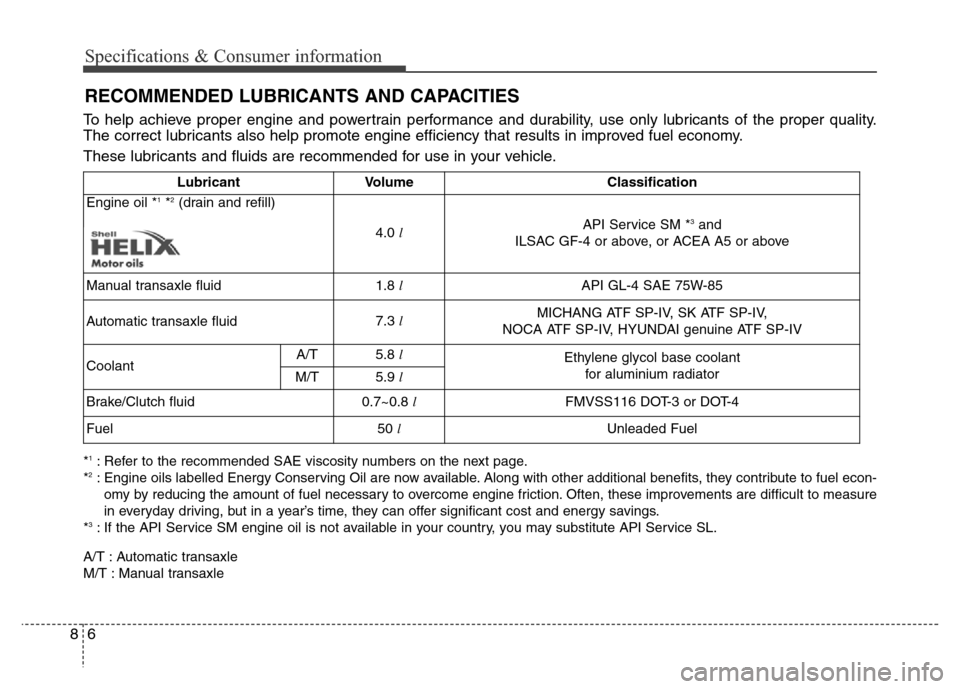
Specifications & Consumer information
6 8
RECOMMENDED LUBRICANTS AND CAPACITIES
*1: Refer to the recommended SAE viscosity numbers on the next page.
*2: Engine oils labelled Energy Conserving Oil are now available. Along with other additional benefits, they contribute to fuel econ-
omy by reducing the amount of fuel necessary to overcome engine friction. Often, these improvements are difficult to measure
in everyday driving, but in a year’s time, they can offer significant cost and energy savings.
*
3: If the API Service SM engine oil is not available in your country, you may substitute API Service SL.
A/T : Automatic transaxle
M/T : Manual transaxle
To help achieve proper engine and powertrain performance and durability, use only lubricants of the proper quality.
The correct lubricants also help promote engine efficiency that results in improved fuel economy.
These lubricants and fluids are recommended for use in your vehicle.
Lubricant Volume Classification
Engine oil *1*2(drain and refill)
4.0 lAPI Service SM *3and
ILSAC GF-4 or above, or ACEA A5 or above
Manual transaxle fluid1.8 l
API GL-4 SAE 75W-85
Automatic transaxle fluid7.3 lMICHANG ATF SP-IV, SK ATF SP-IV,
NOCA ATF SP-IV, HYUNDAI genuine ATF SP-IV
CoolantA/T5.8 l
Ethylene glycol base coolant
for aluminium radiator
M/T5.9 l
Brake/Clutch fluid0.7~0.8 l
FMVSS116 DOT-3 or DOT-4
Fuel50 l
Unleaded Fuel
Page 496 of 498
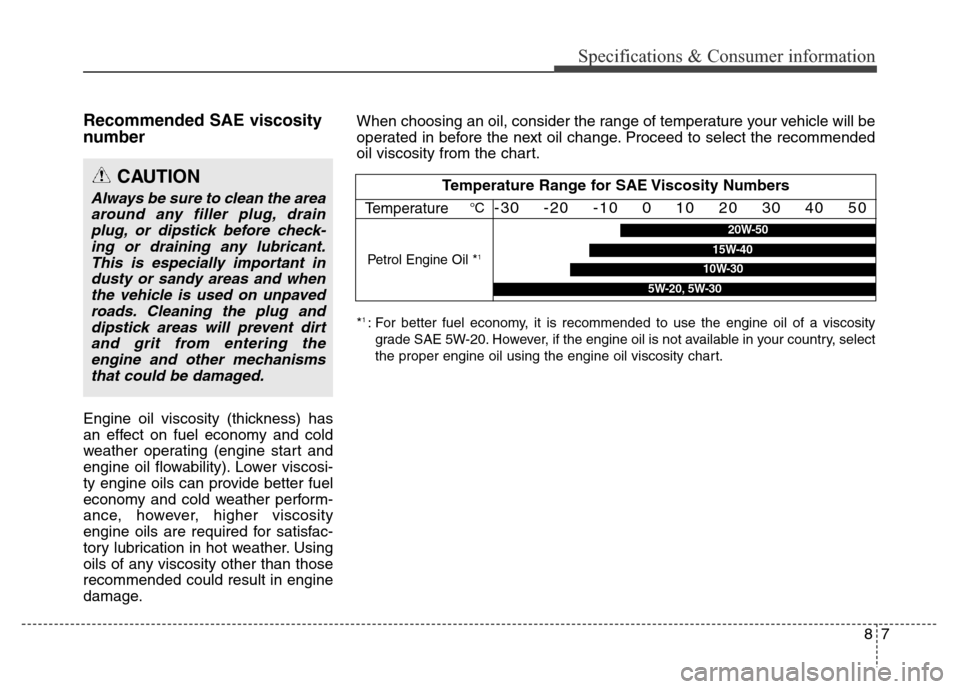
87
Specifications & Consumer information
Recommended SAE viscosity
number
Engine oil viscosity (thickness) has
an effect on fuel economy and cold
weather operating (engine start and
engine oil flowability). Lower viscosi-
ty engine oils can provide better fuel
economy and cold weather perform-
ance, however, higher viscosity
engine oils are required for satisfac-
tory lubrication in hot weather. Using
oils of any viscosity other than those
recommended could result in engine
damage.
CAUTION
Always be sure to clean the area
around any filler plug, drain
plug, or dipstick before check-
ing or draining any lubricant.
This is especially important in
dusty or sandy areas and when
the vehicle is used on unpaved
roads. Cleaning the plug and
dipstick areas will prevent dirt
and grit from entering the
engine and other mechanisms
that could be damaged.
When choosing an oil, consider the range of temperature your vehicle will be
operated in before the next oil change. Proceed to select the recommended
oil viscosity from the chart.
Temperature Range for SAE Viscosity Numbers
Temperature°C-30 -20 -10 0 10 20 30 40 50
20W-50
10W-30
15W-40
5W-20, 5W-30
Petrol Engine Oil *1
*1 : For better fuel economy, it is recommended to use the engine oil of a viscosity
grade SAE 5W-20. However, if the engine oil is not available in your country, select
the proper engine oil using the engine oil viscosity chart.